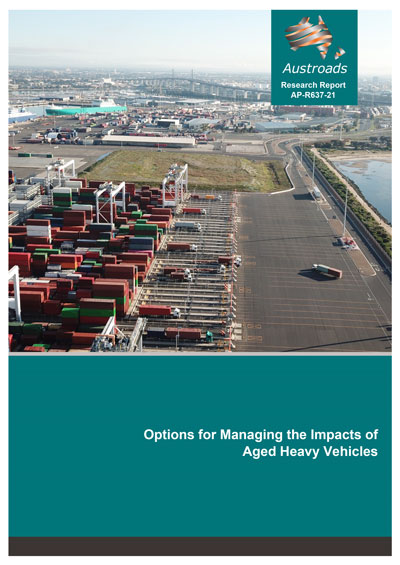Freight

- Publication no: AP-R637-21
- ISBN: 978-1-922382-31-3
- Published: 8 April 2021
- PDF (free) Download
This report investigates policy options for reducing the harmful effects of the oldest trucks operating on Australian and New Zealand roads.
Aged trucks impose a financial burden on the community through their effects on human health and the environment. This study analysed the contribution of aged trucks in two of these areas: their representation in casualty crashes, and their contribution to pollution-related health costs. The analysis focused on heavy vehicles above 4.5 tonnes GVM used in freight transport.
The research identified measures that have been effective in other jurisdictions to influence the use of older trucks. It assessed these options for their likely effectiveness in Australia and New Zealand. The methodology included a literature review, consultation with government and industry, and an options analysis to prioritise suitable measures.
Watch the webinar about the main findings of the study.
- Summary
- Glossary
- 1. Introduction
- 1.1 Problem Statement
- 1.2 Purpose
- 1.3 Scope
- 1.4 Methodology
- 2. Key Issues
- 2.1 Age of the Fleet
- 2.2 Defining Older Trucks
- 2.3 Harmful Effects of Aged Trucks
- 3. Where and How Aged Trucks are Used
- 3.1 The Truck Life Cycle
- 3.2 Urban vs Regional Effects
- 3.3 Fleet Utilisation
- 4. Effects of Aged Trucks on Health and Safety
- 4.1 Modelling the Health Costs of Aged Trucks
- 4.1.1 Modelling Methodology and Data
- 4.1.2 Business-As-Usual Costs
- 4.1.3 Scenario 1: New-for-Old Replacement
- 4.1.4 Scenario 2: Trickle-Down
- 4.1.5 Modelling Summary
- 4.1.6 Un-costed Health Impacts
- 4.2 Non-Pollutant Emissions
- 4.2.1 Greenhouse Gases (CO2)
- 4.2.2 Noise
- 4.3 Road Accidents
- 4.3.1 Road Accident Data
- 4.3.2 Crash Frequency
- 4.3.3 Crash Causes
- 4.1 Modelling the Health Costs of Aged Trucks
- 5. Why Aged Trucks Are Used: Market & Policy Drivers
- 5.1 Types of Freight Carried by Aged Trucks
- 5.2 Covid-19 and Other Market Shocks
- 5.3 Policy Context
- 5.4 Barriers to Upgrading the Aged Truck Fleet
- 5.4.1 Individual Operator Perspective
- 5.4.2 Market Perspective
- 5.4.3 Social Licence perspective
- 5.5 Future Forces: Technology Disruption
- 6. Policies to Manage the Use of Aged Vehicles
- 6.1 Access Restrictions
- 6.1.1 International – Age or Emissions Limits
- 6.1.2 International – Low Emission Zones (LEZ)
- 6.1.3 Australia and New Zealand
- 6.2 Financial Incentives and Disincentives
- 6.2.1 International
- 6.2.2 Australia and New Zealand
- 6.3 Grants or Scrappage Incentives
- 6.3.1 International
- 6.3.2 Insights
- 6.4 Retrofit and Repower Programs
- 6.4.1 International
- 6.4.2 Australia and New Zealand
- 6.5 Policy Lessons for Australia and New Zealand
- 6.6 Industry perspective
- 6.1 Access Restrictions
- 7. Evaluating Options for Australia and NZ
- 7.1 Assessment Methodology
- 7.2 Results and Insights
- 7.2.1 Scores
- 7.2.2 Individual Actions
- 7.2.3 Combined Actions
- 8. Conclusions
- References
- Appendix A Heavy Vehicle Emissions Standards
- Appendix B Aged Vehicle Usage (Location, Load)
- B.1 Locations of Aged Vehicle Use
- B.1.1 Data Sources
- B.1.2 Metrics
- B.2 The Types of Freight that Aged Trucks Carry
- B.2.1 Data Sources
- B.1 Locations of Aged Vehicle Use
- Appendix C Heavy Vehicle Fuel Consumption
- C.1 Road Freight Contribution to Australian Diesel Usage
- C.2 Fuel Consumption of Aged Trucks
- Appendix D Methodology and References for Calculating Health Costs
